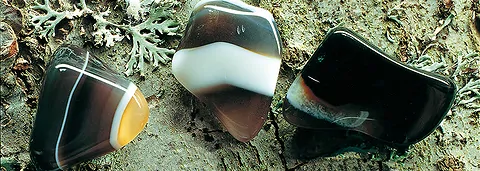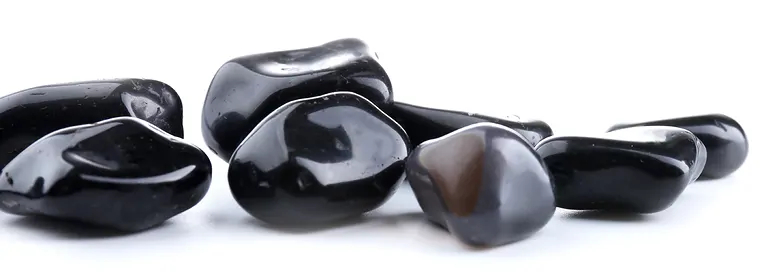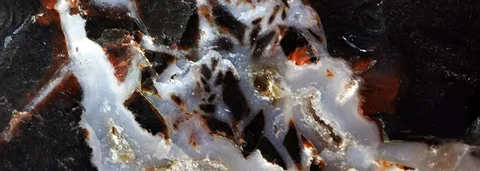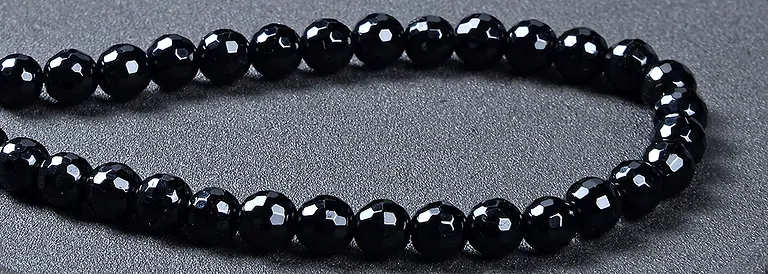
Onyx & Sardonyx - meaning, effort and application
Onyx promotes our ability for self-realization. Goals that have been set but not yet achieved can be pursued more intensively without being distracted or influenced by our fellow human beings or circumstances. Healthy egoism is supported so that differences can arise. Onyx gives us the power of analytical thinking and logical action. Sardonyx gives us confidence and joy, which also has an infectious effect on others. In this way, many projects gain momentum before the winter rest.
Mineralogical profile of onyx and sardonyx
Chemical formula: SiO2
Mineral class: oxide, quartz group, chalcedony variety
Formation: as lining of almond spaces, as stalactites and pseudomorphs (onyx) or magmatic, as spheres or almonds in silica-poor volcanic rocks, e.g. melaphyre, porphyry (sardonyx)
Color: grey to black, sometimes with white banding or veining (onyx) or brown-black with shades of white and red (sardonyx). As the brown part of sardonyx can also be very dark, it is not always possible to differentiate exactly between onyx and sardonyx.
Luster: Silky luster
Crystal system: trigonal
Mohs hardness: 6.5 to 7
Cleavage, fracture: no cleavage; uneven, scaly or conchoidal fracture
Occurrence, main supplier countries: Brazil, Mexico, India, South Africa (onyx) and southern Brazil (Rio Grande do Sul, area around Salto de Jucai and Irai), Uruguay, USA, Mexico (sardonyx). The historically important sites in the Mainz Basin provided the basis for the jewelry industry in nearby Idar-Oberstein. In Germany, onyx was mined in the Iberg (Yberg) and Peter quarries near Baden-Baden, which have since been closed down. Onyx is mined on a very small scale in the Plieskendorf gravel pits near Lübbenau and Saalhausen near Großräschen in Brandenburg.
Appearance: fibrous aggregates (onyx), nodules (onyx and sardonyx)
Sardonyx and onyx articles for retailers and resellers
Usage: Onyx is a classic gemstone in rings, bracelets, necklaces and other pieces of jewelry. The all-black onyx in particular is often worn as a tie pin or cufflinks for black-tie occasions. The use of black onyx in mourning jewelry is also historically documented, especially in Victorian England.
In gemstone healing, it is used to strengthen self-confidence and assertiveness. Onyx is used to develop a healthy ego. Onyx is said to train analytical thinking. In astrology, it is used to support the self-realization and assertiveness of Capricorn-born people.
Sardonyx is a historically significant gemstone, a lay stone from which multicolored gems and signet rings were cut. In gemstone healing, it is used to improve and refine all the senses. Astrology uses sardonyx to improve the sensitivity of people born in Capricorn.
Name and synonyms onyx and sardonyx
The term onyx is used to describe pure black and also black and white varieties of chalcedony or agate. In agate, the layers are clearly recognizable and differently coloured; if the gemstone is optically unstructured, it is called chalcedony. Both agate and chalcedony are varieties of the mineral quartz (SiO2). Uniform yellow-red, red and brown chalcedony is known as carnelian (sard). Combinations of white, black and red-brown colors are called sardonyx.
The name “onyx” originated in the Middle Ages via Latin from the Greek “onyx” (fingernail, claw). The name presumably alludes to the white stripes, which are reminiscent of the light-colored areas in the fingernail.
Onyx marble is a limestone in beige, brown and olive green; onyx marble is also known as Turkish onyx or Mexican onyx.
Onyx - colored or natural?
The jewelry industry in particular has a higher demand for uniformly deep black onyx. This is why some of the onyx on the market is artificially recolored. A historical process is the immersion of porous agates in a sugar solution and subsequent heating, during which the sugar is converted into carbon. The onyx treated in this way is characterized by a uniform black color; uncoloured onyx tends to be dark grey.
Stringed beads, donuts, tumbled stones and more onyx and sardonyx item for retailers
Onyx and its historical use
Onyx (shoham) is mentioned in various texts in the Old Testament, e.g. as part of the clothing of the high priest Aron (Genesis 2:12). However, this is not black or black and white onyx, but a beige-brown material. Onyx was already used to make bowls in ancient Egypt. Whether it is black and white onyx or the green-beige onyx marble is still disputed among experts.
In the 1920s and 1930s, onyx was used by Ferdinand Preiss and other craftsmen; however, this is clearly onyx marble. The same applies to the interior design elements created by Mies van der Rohe in the Villa Tugendhat. The famous staircases in the Hôtel de la Païva in Paris and the cladding of the lobby in the Mariinsky Theater in St. Petersburg are also made of onyx marble. It is not yet clear what the black Jahangir throne in Agra, India, is made of - it could be an artisanal piece made entirely of onyx or another material that is (partially) decorated with onyx panels.


